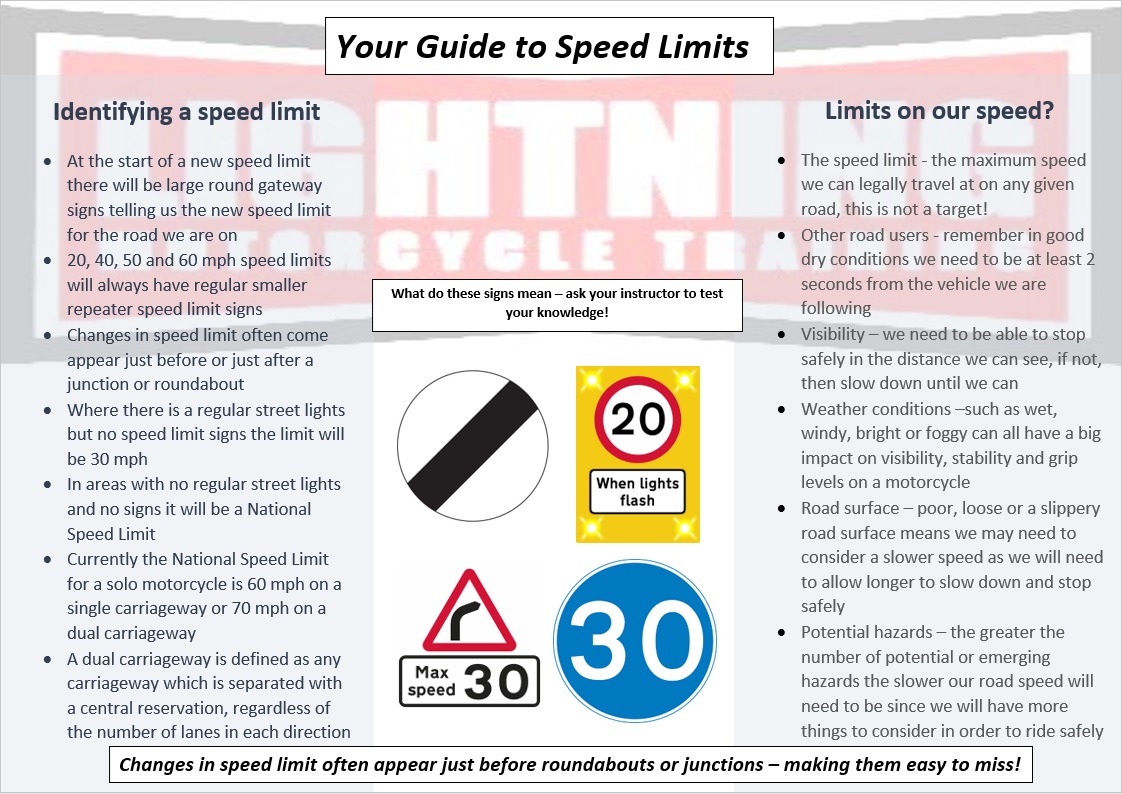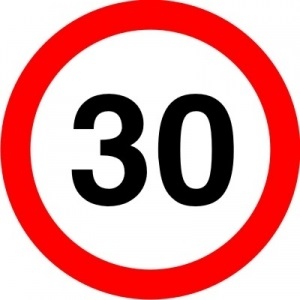Speed Limits

Are you struggling to observe Speed Limits? Read on..
If you break a speed limit, except for in very rare circumstances, you will fail your Module 2 Test. But more importantly this is a significant breach of Road Safety and you’re putting yourself and others at risk. While it may be true that excess speed is not necessarily the biggest cause of accidents it is certainly the single biggest factor in the outcome of any accident. That said it is not unreasonable to argue that most accidents involving two or more vehicles occur when one party does something that the other party does not anticipate and has too much speed to be able to stop for the circumstances. This, then, is a subject that needs to be treated with some respect – and rightly the DVSA examiners are not going to cut test candidates a lot of slack if they don’t obey the speed limit.
FAQ
1/. How do I know what the speed limit is?
There are some straight-forward rules of thumb that can help you work out the speed limit. By default, any single carriageway that has lamp posts is 30mph and any single carriageway without lampposts is 60mph (for a motorcycle). Any single carriageway that is 20, 40 or 50mph will be shown by repeater signs that occur either approximately every 200 yards or on every 7th or 8th lamp post. A road that is 30mph without lamp posts will also have repeater signs, and a road with lamp posts that is still 60mph will have national speed limit repeater signs. The exception to this is motorways and dual carriageways which are by default 70mph (for a motorcycle) even with lamp posts unless marked otherwise by repeater signs.
2/. What is a Repeater Sign?
A Repeater Sign is a slightly smaller than normal speed limit sign that usually appears on its own (rather than in pairs like a speed limit change). They can be on either side of the road and are normally attached to lamp posts, other road sign posts or their own small post.
3/. Where can I expect a speed limit change?
Glad you asked that as this is the systemic fault in failing a test on speed limits. Speed limits occur in several places; the easiest ones being as you approach a village or built up area. These ones are easy to spot and anticipate as they occur directly in your line of sight. The next most common are as you turn in or out of a side road; these are quite easy to miss as students are frequently concentrating on trying to look right-left-right to emerge from a junction or doing a lifesaver just as they turn in. This can be overcome by anticipating a change and looking further ahead on the approach to a junction to specifically check if there will be a new speed limit. Finally, there is either approaching or leaving a roundabout and the same advice as junctions applies – plan ahead!
4/. Help! I turned into a road and I’m not sure if there was a speed limit change – what should I do?
Well first of all do not guess it by the size of the road or by the actions of other road users – in fact definitely do not guess! The safest thing to do is start by doing the lowest speed limit. This can vary a little bit depending on where you are but as a simple guide many cities and towns have 20mph speed limits now, whereas most villages are still 30mph. So, having started by doing the lowest speed limit you need to support this with fact; firstly is there a change of speed limit down any side roads? – if there is then whatever it says will not be the same as the road you’re on, so for example if it says 20mph down a side road then the road you’re on must be at least 30mph – so speed up. Secondly, are there any lamp posts? Finally, are there any repeater signs? This may mean going a few hundred yards comparatively slowly but if there are no lamp posts and no repeater signs then it must be 60mph, alternatively if there are lamp posts but no repeater signs then it must be 30mph – and so on. Follow this advice and generally all you will get is a minor (rider) fault for missing the initial speed limit change.
5/. So, is it okay just to do the lowest speed limit everywhere?
No – the examiner will expect you to ride up to the speed limit where the road is clear and safe. If you do 20mph in a 30mph zone and ignore all the evidence that tells you it is 30mph (i.e. no repeater signs on the lamp posts) then this will be a serious fault unless there was good reason to be doing less than 30mph, such as slow traffic.
6/. Do I need to go fast through bends and junctions?
Absolutely not! These should be done at a speed you are comfortable with; you should only ride up to the speed limit where the road is clear and straight (i.e. you can see to stop safely).
7/. What happens if the vehicle in front is travelling less than the speed limit?
As an absolute priority you must not get inside two seconds of the vehicle in front regardless of the speed limit (or four seconds if it is wet). Then you need to consider your options – you will be expected to overtake vehicles where it is safe to do so. However, this does not mean you can break the speed limit in so doing; if the speed limit is 50mph on a single carriageway and the vehicle in front is doing 45mph then you are going to need a very long straight bit of road to get past them safely. Alternatively, if you are on a dual carriageway then you should consider using the outside lane to overtake provided you do not cause others to swerve or slow down.
8/. Under what circumstances could I break the speed limit and not get a serious fault?
Very unusual ones! However, some test centres do have the odd route where the road signs are poor (Farnborough) and it is possible to enter a speed limit change with nothing to indicate or warn you of this change. Under these circumstances the examiner would advise you that the speed limit has changed – what we call “local knowledge”. You should not need to know test routes to pass a test and the examiners are aware of this. The other occasion is when you need to be pragmatic, in particular when you are overtaking. If you do this slowly you can easily get into a situation where the vehicle in front starts to match your speed – if you go fractionally over the speed limit to make the overtake stick this is safer than riding side by side with another vehicle up a dual carriageway. Unfortunately, if you’ve got yourself into this situation it does tend to imply the whole manoeuvre was not very well thought out!

